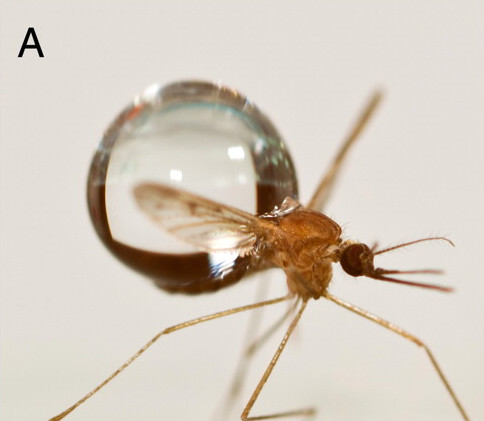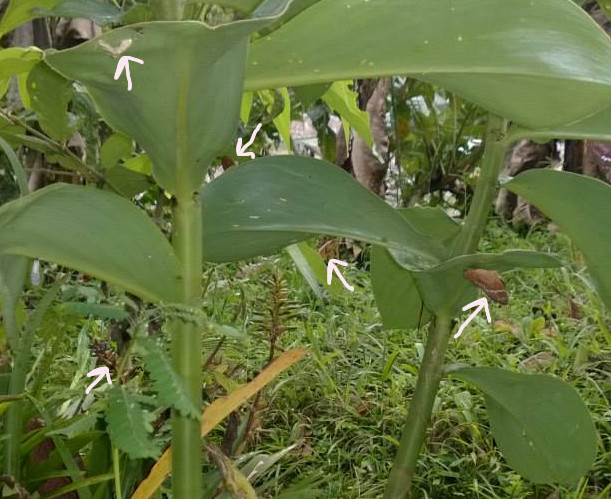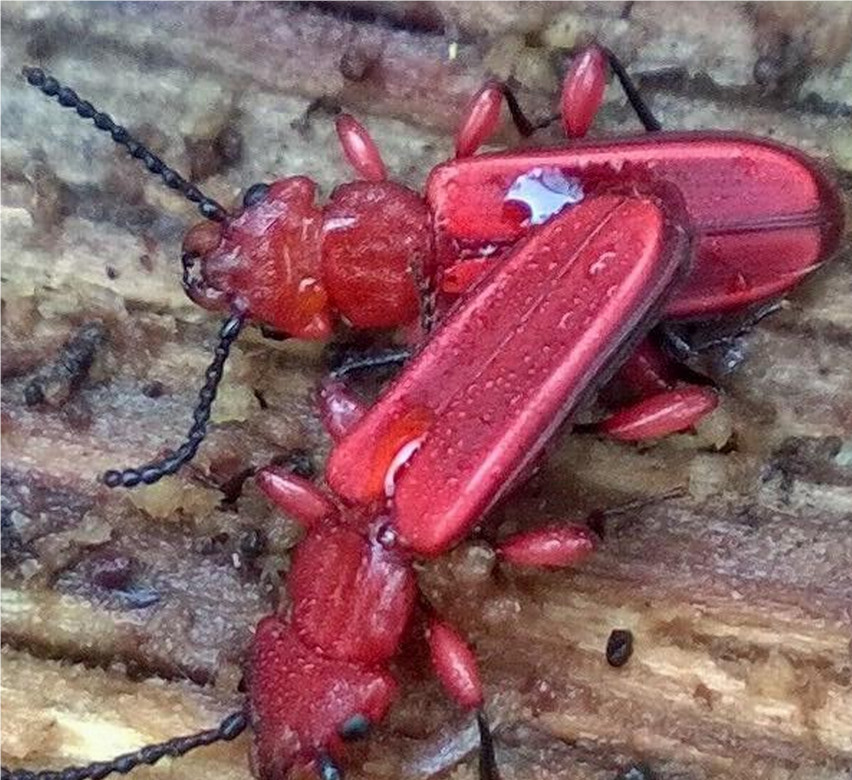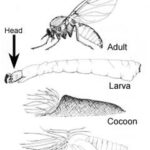Can Bugs Fly In The Rain? Bugs can fly in the rain, but it depends on the species and their specific adaptations. At flyermedia.net, we dive into the fascinating world of insect behavior, particularly how these tiny creatures navigate the challenges posed by rainfall, impacting various aspects of aviation and outdoor activities. Discover how insects adapt to wet conditions and what it means for you, enhanced by expert insights and real-world examples.
1. Understanding Insect Flight in Adverse Weather
1.1. How Does Rain Affect Insect Flight?
Rain significantly impacts insects in flight. Raindrops, relative to an insect’s size, are like massive projectiles. These raindrops can weigh insects down, damage their wings, and reduce their ability to fly efficiently. High winds accompanying rainstorms further complicate matters, pushing insects off course and forcing them to expend more energy to maintain their trajectory. However, insects have developed various strategies to cope with these challenges.
1.2. Insects and Ectothermic Adaptations
Insects are ectothermic, meaning their body temperature is heavily influenced by the surrounding environment. This characteristic affects their activity levels; cold temperatures slow them down, while warmer temperatures make them more active. As Nancy Miorelli points out, insects employ several tricks to deal with inclement weather, compensating for their vulnerability to environmental changes.
1.3. The Impact of Raindrop Size on Insects
The size of raindrops relative to an insect is critical. Research by Dickerson et al. (2012) illustrates how mosquitoes, for example, are so small that many raindrops miss them entirely. If a mosquito is hit, it becomes momentarily integrated into the raindrop and falls with it, but their water-resistant hairs help them quickly escape the water droplet.
 Raindrop size in relation to a mosquito
Raindrop size in relation to a mosquito
2. Strategies for Survival: How Bugs Cope with Rain
2.1. Seeking Shelter: A Common Insect Behavior
Many insects avoid flying in heavy rain by seeking shelter. Bees, for example, often stay inside their hives when they sense an approaching storm, thanks to their ability to detect atmospheric pressure changes. Similarly, other insects, like butterflies, may hunker down under leafy plants, waiting for the storm to pass.
2.2. Staying Active: The Advantage of Reduced Competition
Some insects, particularly those thriving in warm, humid environments, continue to fly in the rain. Mosquitoes are prime examples, as their ability to withstand rainfall reduces competition from other insects. This allows them to continue feeding when others cannot, ensuring their survival and reproductive success.
2.3. Reproductive Strategies: Waiting for the Rain
Certain insects time their reproductive cycles to coincide with rainfall. Leafcutter ants in Texas, for instance, fly just after rain on moonless nights in early spring. Rain beetles are another group that emerge during the rain, with females releasing pheromones to attract males for mating.
3. Detailed Insect Behaviors During Rainfall
3.1. Honey Bees: The Homebodies
Honey bees are known to stay in their hives when they sense changes in atmospheric pressure indicating an upcoming storm. This behavior helps them conserve energy and avoid the dangers of flying in wet and windy conditions.
3.2. Mason Bees: Flexible Foragers
Mason bees may forage in light rain but will seek shelter when the rain becomes too heavy or the wind intensifies. This flexibility allows them to maximize their foraging opportunities while minimizing the risks associated with adverse weather.
3.3. Butterflies: Taking Cover
Butterflies often take cover under leaves or in sheltered spots during rainstorms. This behavior protects their delicate wings from damage and prevents them from being weighed down by water droplets.
 Resting butterflies found after a storm
Resting butterflies found after a storm
3.4. Red Flat Bark Beetles: Hiding Away
Red Flat Bark Beetles hide under bark during wet conditions, avoiding exposure to the rain. This behavior helps them stay dry and protected from the elements.
 Red Flat Bark Beetles hiding under bark
Red Flat Bark Beetles hiding under bark
4. Scientific Insights into Insect Rain Resistance
4.1. Mosquitoes and Raindrop Impact
Research has shown that mosquitoes can withstand the impact of raindrops due to their small size and water-resistant hairs. When hit by a raindrop, they briefly become part of it but quickly escape, minimizing any harm.
4.2. The Role of Water-Resistant Hairs
The water-resistant hairs on mosquitoes and other insects play a crucial role in their ability to fly in the rain. These hairs prevent water from clinging to their bodies, reducing the risk of being weighed down.
4.3. Evolutionary Adaptations for Rain Survival
Insects have evolved various adaptations to survive in rainy conditions, including behaviors like seeking shelter, flying strategically, and timing reproductive cycles with rainfall. These adaptations highlight the resilience and adaptability of insects in diverse environments.
5. The Broader Ecological Context
5.1. Insects in Aquatic Environments
Many insects live in aquatic environments, where rain has little to no adverse effect on them. These insects are well-adapted to life in water and are not negatively impacted by rainfall.
5.2. The Impact of Rain on Insect Populations
While some insects are negatively affected by rain, others benefit from it. Rain can create favorable conditions for breeding and foraging, leading to population increases in certain insect species.
5.3. Insects and Climate Change
Climate change is altering rainfall patterns, which can have significant impacts on insect populations. Changes in rainfall can affect insect breeding cycles, foraging opportunities, and overall survival rates. Understanding these impacts is crucial for predicting and managing insect populations in a changing world.
6. Insect Flight Mechanics in the Rain
6.1. How Insects Adjust Their Flight
Insects adjust their flight mechanics in several ways to cope with rain. They may fly lower to the ground to avoid strong winds, or they may increase their wingbeat frequency to maintain stability in wet conditions.
6.2. Wing Structure and Rain Resistance
The structure of insect wings also plays a role in their ability to fly in the rain. Some insects have wings with hydrophobic surfaces that repel water, while others have specialized structures that help them shed water quickly.
6.3. Energy Expenditure During Rainy Flights
Flying in the rain requires more energy than flying in dry conditions. Insects must work harder to overcome the added weight of water droplets and the resistance of wind and rain.
7. Case Studies of Insect Rain Adaptation
7.1. Mosquitoes in Tropical Rainforests
Mosquitoes in tropical rainforests are well-adapted to flying in rainy conditions. They have evolved specialized behaviors and physical adaptations that allow them to thrive in these wet environments.
7.2. Rain Beetles in Arid Regions
Rain beetles in arid regions rely on rainfall to trigger their reproductive cycles. Their life cycle is closely tied to the timing of rain, highlighting their unique adaptation to dry environments.
7.3. Leafcutter Ants in Texas
Leafcutter ants in Texas time their mating flights to coincide with rainfall, taking advantage of the moist conditions to establish new colonies.
8. The Effects of Heavy Rainfall on Insect Habitats
8.1. Flooding and Insect Survival
Heavy rainfall can lead to flooding, which can devastate insect habitats. Flooding can drown insects, destroy their food sources, and disrupt their breeding cycles.
8.2. Soil Saturation and Burrowing Insects
Soil saturation from heavy rainfall can make it difficult for burrowing insects to dig and maintain their burrows. This can lead to increased mortality rates in these species.
8.3. Changes in Vegetation and Insect Diets
Heavy rainfall can alter vegetation patterns, which can affect the diets of herbivorous insects. Changes in vegetation can lead to shifts in insect populations and community structure.
9. Human Perspectives on Insects Flying in the Rain
9.1. Pest Control and Rainy Weather
Rainy weather can affect the effectiveness of pest control measures. Some pesticides may be washed away by rain, reducing their impact on target insect populations.
9.2. Agriculture and Insect Activity During Rain
Rain can influence insect activity in agricultural settings. Some insects may become more active during or after rain, leading to increased crop damage, while others may seek shelter and reduce their feeding.
9.3. Public Health and Mosquito-Borne Diseases
Rain can increase the risk of mosquito-borne diseases by creating breeding sites for mosquitoes. Public health officials often implement mosquito control measures during and after rain to reduce the risk of disease transmission.
10. Future Research and Technological Innovations
10.1. Studying Insect Flight with Advanced Technology
Advanced technologies, such as high-speed cameras and wind tunnels, are being used to study insect flight in rainy conditions. These technologies provide valuable insights into the mechanics of insect flight and their adaptations to rain.
10.2. Developing Rain-Resistant Insecticides
Researchers are working on developing rain-resistant insecticides that can withstand heavy rainfall and remain effective for longer periods. These insecticides could help reduce crop damage and the spread of insect-borne diseases.
10.3. Climate Modeling and Insect Population Prediction
Climate modeling is being used to predict how changes in rainfall patterns will affect insect populations in the future. This information can help inform conservation and management strategies.
11. Insects and Aviation Safety
11.1. Insect Swarms and Flight Visibility
Insect swarms can reduce flight visibility, posing a risk to aviation safety. Pilots need to be aware of the potential for insect swarms and take appropriate precautions.
11.2. Insect Ingestion and Engine Performance
Insects can be ingested into aircraft engines, potentially affecting their performance. Aircraft manufacturers design engines to minimize the risk of insect ingestion and its impact on engine function.
11.3. Airport Pest Control Strategies
Airports implement pest control strategies to minimize the presence of insects that could pose a risk to aviation safety. These strategies include habitat management, insecticide applications, and monitoring programs.
12. Educational Resources on Insect Biology
12.1. University Programs in Entomology
Universities offer programs in entomology that provide students with a comprehensive understanding of insect biology, ecology, and behavior. These programs prepare students for careers in research, pest management, and conservation. Embry-Riddle Aeronautical University offers several programs related to aerospace, engineering, and aviation that touch on entomology, in July 2025, P provides Y.
12.2. Online Courses and Workshops
Online courses and workshops offer accessible educational resources on insect biology for students and professionals. These resources cover a wide range of topics, from insect identification to pest management strategies.
12.3. Citizen Science Projects
Citizen science projects engage the public in collecting data on insect populations and behavior. These projects provide valuable information for researchers and promote public awareness of insect biology and conservation.
13. Understanding Insect Habitats and Behaviors
13.1. Insects’ Impact on Daily Life
Insects play a significant role in our daily lives, often unnoticed. They contribute to pollination, decomposition, and serve as a food source for various animals. Understanding their habitats and behaviors helps us appreciate their ecological importance.
13.2. Insects as Indicators of Environmental Health
Insects are excellent indicators of environmental health. Changes in their populations or behavior can signal pollution, habitat destruction, or climate change, providing valuable insights for conservation efforts.
13.3. Insect Habitats Around the World
From tropical rainforests to arid deserts, insects inhabit nearly every environment on Earth. Each habitat presents unique challenges and opportunities, shaping the adaptations and behaviors of the insects that live there.
14. The Interplay Between Insects and Weather Conditions
14.1. Humidity and Insect Activity
Humidity levels can significantly influence insect activity. Many insects thrive in humid conditions, as moisture is essential for their survival and reproduction.
14.2. Temperature and Insect Metabolism
Temperature plays a critical role in insect metabolism. Warmer temperatures generally increase insect activity and metabolism, while colder temperatures slow them down.
14.3. Wind and Insect Dispersal
Wind can aid in insect dispersal, allowing them to colonize new areas and find food sources. However, strong winds can also be detrimental, pushing insects off course and making it difficult for them to fly.
15. Exploring Insect Communication Methods
15.1. Pheromones and Insect Attraction
Pheromones are chemical signals that insects use to communicate with each other. They play a key role in attracting mates, signaling danger, and coordinating social behavior.
15.2. Visual Signals in Insect Communication
Visual signals, such as flashing lights and colorful patterns, are also used by insects to communicate. These signals can attract mates, warn predators, and establish territory.
15.3. Auditory Communication Among Insects
Auditory communication, such as chirping and buzzing, is common among insects. These sounds can attract mates, defend territory, and signal alarm.
16. Insect Migration and Seasonal Behaviors
16.1. Monarch Butterfly Migration Patterns
Monarch butterflies are famous for their long-distance migration, traveling thousands of miles each year to reach their overwintering grounds. This migration is triggered by seasonal changes and involves multiple generations of butterflies.
16.2. Locust Swarms and Environmental Triggers
Locust swarms are triggered by environmental conditions, such as rainfall and vegetation growth. These swarms can cause widespread crop damage and pose a threat to food security.
16.3. Seasonal Adaptations of Insects
Insects have evolved various seasonal adaptations to survive in changing environments. These adaptations include hibernation, migration, and changes in behavior and physiology.
17. The Role of Insects in Pollination
17.1. Bees as Primary Pollinators
Bees are among the most important pollinators, responsible for pollinating many crops and wild plants. Their hairy bodies and specialized behaviors make them efficient pollen carriers.
17.2. Other Insect Pollinators
Other insects, such as butterflies, moths, flies, and beetles, also contribute to pollination. These insects play a crucial role in maintaining biodiversity and supporting agricultural productivity.
17.3. The Impact of Insecticides on Pollinators
Insecticides can harm pollinators, reducing their populations and disrupting pollination services. Sustainable pest management practices are needed to protect pollinators and ensure the continued availability of pollination services.
18. Insects and Their Interactions with Plants
18.1. Herbivorous Insects and Plant Defenses
Herbivorous insects feed on plants, and plants have evolved various defenses to protect themselves from insect attack. These defenses include physical barriers, chemical compounds, and symbiotic relationships with other organisms.
18.2. Beneficial Insects and Pest Control
Beneficial insects, such as predators and parasitoids, can help control pest populations. These insects play a key role in integrated pest management strategies and reduce the need for chemical insecticides.
18.3. Insect-Plant Coevolution
Insects and plants have coevolved over millions of years, shaping each other’s traits and behaviors. This coevolution has led to complex and fascinating relationships between insects and plants.
19. Insects as a Sustainable Food Source
19.1. Entomophagy: Eating Insects
Entomophagy, or eating insects, is a common practice in many cultures around the world. Insects are a nutritious and sustainable food source, rich in protein, vitamins, and minerals.
19.2. Insect Farming and Food Security
Insect farming is a growing industry that aims to produce insects as a sustainable food source. Insect farms can be more efficient and environmentally friendly than traditional livestock farming.
19.3. The Future of Insects as Food
Insects have the potential to play a significant role in addressing global food security challenges. As the world’s population grows, insects may become an increasingly important source of protein and other nutrients.
20. Insects and Medical Research
20.1. Insects as Models for Human Diseases
Insects are used as models for studying human diseases, such as malaria, dengue fever, and Zika virus. Their relatively simple genetics and short life cycles make them valuable tools for medical research.
20.2. Insect-Derived Compounds for Drug Development
Insects produce a variety of compounds that have potential applications in drug development. These compounds are being studied for their antimicrobial, antiviral, and anticancer properties.
20.3. The Use of Insects in Forensic Science
Insects are used in forensic science to estimate the time of death in criminal investigations. The succession of insects that colonize a dead body can provide valuable information for investigators.
21. Overcoming Challenges in Insect Photography
21.1. Tips for Capturing Insects in Motion
Capturing insects in motion requires patience, skill, and the right equipment. Using a fast shutter speed, a macro lens, and good lighting can help you capture stunning images of insects in action.
21.2. Equipment Recommendations for Insect Photography
Choosing the right equipment is essential for insect photography. A macro lens, a tripod, and a flash can help you capture sharp, detailed images of insects in their natural habitats.
21.3. Ethical Considerations in Insect Photography
Ethical considerations are important in insect photography. Avoid disturbing insects or their habitats, and never harm an insect for the sake of a photograph.
22. Engaging Children with the Wonders of Insects
22.1. Educational Games and Activities
Educational games and activities can help children learn about insects in a fun and engaging way. These activities can teach children about insect biology, ecology, and conservation.
22.2. Insect Observation in the Garden
Observing insects in the garden can be a great way for children to connect with nature and learn about the diversity of insect life. Encourage children to look for insects in flowers, on leaves, and in the soil.
22.3. Raising Insects as a Classroom Project
Raising insects as a classroom project can provide children with a hands-on learning experience. This project can teach children about insect life cycles, behavior, and habitat requirements.
23. Frequently Asked Questions (FAQs) About Insects Flying in the Rain
23.1. Why Do Some Bugs Fly in the Rain While Others Don’t?
The decision to fly in the rain depends on the insect’s size, adaptations, and needs. Some insects, like mosquitoes, have adaptations to cope with rain, while others prefer to seek shelter.
23.2. How Do Mosquitoes Avoid Getting Hit by Raindrops?
Mosquitoes are small enough that many raindrops miss them entirely. If hit, their water-resistant hairs help them quickly escape.
23.3. What Happens to Bees During a Rainstorm?
Honey bees typically stay in their hives during rainstorms, while mason bees may forage in light rain but seek shelter when it gets heavier.
23.4. Can Rain Damage an Insect’s Wings?
Yes, heavy rain can damage an insect’s wings, especially if they are delicate. Seeking shelter helps prevent this.
23.5. How Do Insects Sense an Approaching Storm?
Some insects, like honey bees, can sense changes in atmospheric pressure that indicate an approaching storm.
23.6. Do Insects Get Cold in the Rain?
Yes, as ectothermic creatures, insects’ body temperature is affected by the environment. Rain can lower their body temperature, slowing them down.
23.7. What Is the Role of Water-Resistant Hairs on Insects?
Water-resistant hairs prevent water from clinging to their bodies, reducing the risk of being weighed down.
23.8. How Does Rain Affect Insect Reproduction?
Some insects time their reproduction with rainfall, as rain can create favorable conditions for breeding.
23.9. Are There Any Insects That Benefit From Rain?
Yes, some insects, like rain beetles, rely on rainfall for their reproductive cycles.
23.10. How Does Climate Change Affect Insects’ Ability to Fly in the Rain?
Changes in rainfall patterns due to climate change can affect insect populations, their breeding cycles, and overall survival rates.
24. Join the Aviation Community at Flyermedia.net
24.1. Discover Pilot Training Programs
Looking for the best pilot training programs in the USA? Flyermedia.net offers a comprehensive directory of flight schools, including top-rated institutions like Embry-Riddle Aeronautical University located at Address: 600 S Clyde Morris Blvd, Daytona Beach, FL 32114, United States, Phone: +1 (386) 226-6000. Find the perfect program to match your aviation aspirations.
24.2. Stay Updated with Aviation News
Stay informed with the latest aviation news, insights, and trends on flyermedia.net. Our dedicated team of aviation experts delivers up-to-date information on industry developments, regulatory changes, and technological advancements.
24.3. Explore Career Opportunities in Aviation
Are you seeking a career in aviation? Flyermedia.net features a wide range of job opportunities, from pilot positions to aircraft maintenance roles. Discover your next aviation career move with us.
25. Embrace Your Passion for Flight with Flyermedia.net
Insects can fly in the rain, adapting through various strategies to survive and thrive. Similarly, at flyermedia.net, we provide you with the resources and information you need to navigate the world of aviation. Whether you’re interested in pilot training, industry news, or career opportunities, flyermedia.net is your go-to source. Don’t just dream of flying—make it a reality with flyermedia.net. Explore our website today and take the first step towards your aviation adventure.
